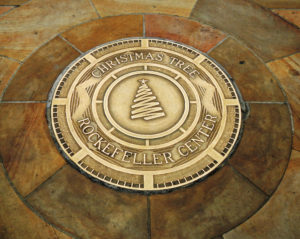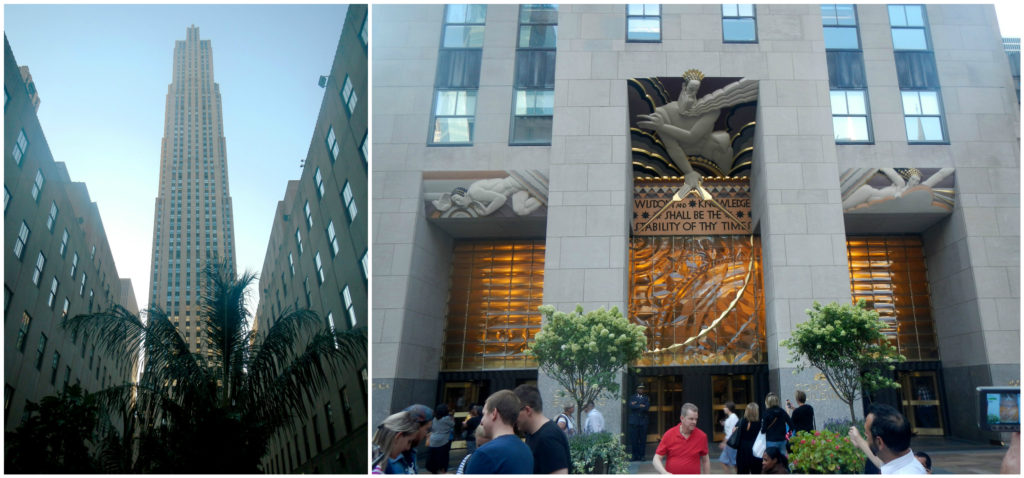The Rockefellers are the richest family in the world. EVER.
J.D. Rockefeller, oil tycoon, became the world’s very first billionaire in 1916. Today with inflation, this amounts to over $350 billion dollars(!). To our luck, the family used a small part of their enormous fortune to build a series of beautiful buildings, complete with public installations of art.
We visited the Rockefeller center and signed up for the Arts & Architecture tour + a visit to the “Top of the Rock,” basically a visit to enjoy the view from the top of 30 Rockefeller, a skyscraper that overlooks Central Park, the Empire State building, and more.
J.D.’s son, J.D. Jr. (whom we will call Junior from hereon out), and his wife Abby were the ones behind the striking and world famous building complex, which started with a plan for a new opera house for NYC. The city didn’t have the funds to secure the land, so Junior helped fund the land acquisition. This was just before the stock market crash of 1929, however, and it turned out the city got distracted from their goal of a new opera house in the short-term future.
Around the same time, NBC was looking for a place to establish their headquarters and signed a contract with Junior to inhabit the property. This place truly was built for radio and eventually, TV.

The famous Radio City Music Hall opened December of 1932 as the largest theater in the world. It started as a place for vaudeville, but this format didn’t really work since such a large room meant most of the 6,000 visitors had to sit too far from the stage to hear well or appreciate the subtleties of players facial expressions. Next, they tried to show movies here with a full opening act of dancing girls (the origin of the famous Rockettes). But this meant that people would have to sit for hours and hours on end. Despite the tremendous success of the 3+ hour-long Lord of the Rings films today, these lengthy shows did not go well for Radio City during that time period.

Junior’s wife Abby is the reason why these buildings are beautiful. An avid art collector, she believed in providing art for the public within the Rockefeller buildings. Junior gave her $150,000 to use to commission art. She spent well over $1 million. Rockefeller center has over 100 pieces of public art on display today. She also founded the Museum of Modern Art (which used to be the Rockefeller mansion).
The ideas of progress and civilization are central to the art and architecture of Rockefeller Center and you can see them in every piece.

30 Rock is the most famous of the Rockefeller buildings, even before Tina Fey’s award-winning show. It’s made of Indiana limestone and was the tallest building in NYC at the time of construction (today, it’s the 5th tallest with 70 floors, which is still mighty tall). The architects learned from the mistakes of the Empire State building, which was nicknamed the “empty building” for its lack of tenants and elevators. 30 Rock has an elevator system that separates elevators out by a grouping of floors, so you never have the chance of accidentally stopping on every floor in the building. It was a success, with 75% occupancy after its construction, during the Great Depression.

It’s the hub of NBC studios. You can see there are no windows in the third and fourth floors, since that’s where they do studio shows and need to be able to control lighting and sound. The walls are hollowed out to allow for technology to get replaced as it becomes outdated. That’s some foresight right there.

 Around the back side of 30 Rockefeller is the famed plaza that’s home to the Christmas tree and outdoor ice rink in winter. The tree is a real Norway spruce decorated with 5 miles of cord and a Swarovski crystal star. Fun fact: once the tree is taken down (about a week after New Years) it’s milled/treated, and the lumber gets donated to habitat to humanity.
Around the back side of 30 Rockefeller is the famed plaza that’s home to the Christmas tree and outdoor ice rink in winter. The tree is a real Norway spruce decorated with 5 miles of cord and a Swarovski crystal star. Fun fact: once the tree is taken down (about a week after New Years) it’s milled/treated, and the lumber gets donated to habitat to humanity.
When the ice rink isn’t around, the sunken central plaza is used for an eating area for a garden bar and restaurant. The flags surrounding it are an homage to the UN with a flag from each UN country. Junior donated the 16 acres of land for the UN headquarters here in NYC ($8M at the time).

It’s also a shopping mecca, with a garden-filled pathway that slopes down in from 5th Avenue, literally using gravity to draw shoppers their way. 5th Avenue used to be known as “millionaire mile” since that was where mansions were of all the richest families. Eventually they moved away and their old houses became famous department stores instead.

The buildings are just as beautiful on the inside as they are on the outside. It might not seem like it, but any person can walk in to the lobbies of any of the Rockefeller buildings (and it’s suggested for some beautiful art/architecture!).



The most famously controversial art piece was created in the lobby of 30 Rock, just as you enter through Wisdom’s doors (the entrance facing the plaza). It was so controversial, it no longer exists there!
Junior reached out to Matisse and Picasso asking for a piece, but never got responses. So he asked Diego Rivera to create a piece. Diego had an idea for a piece called Man at the Crossroads where a figure would be portrayed standing between imagery of capitalism and imagery of communism. It was thought it could show a moment in world history, but Diego (a staunch communist) took it a big too far and at the last minute included a portrait of Vladimir Lenin in the mural as one of the faces in the crowd on the communist side. He’d also painted Junior into the work with other women and holding a drink in his hand, especially insulting as he abstained from alcohol.

Rivera’s al fresco mural was not just paint on the top of the wall, it was effectively part of the wall. Though the Rockefellers asked him to change the mural, Rivera told them he would rather have it destroyed than compromise his artistic integrity. So, it was destroyed.
In its place, Junior commissioned Spanish artist Josep Maria Sert to create his work: a two-toned mural titled American Progress. In it, he painted Abraham Lincoln, who embodies action, working hard and handing equipment over.

A 1941 ceiling mural called Time shows the Present balancing Past (left) and Future (right) on the building columns. As you walk, the image has this beautifully realistic shift (click for video).
After only 90-ish minutes, we learned the basics of the Rockefeller Center history, but our fun wasn’t over. It was time for one of the best views of the city.


We were lucky to head up during daylights final hour and saw the sun set. It was far more crowded once it was dark and taking pictures was a struggle.
Worth the beautiful views though!
Logistics:
Tickets to the Arts & Architecture Tour + Top of the Rock = $44. If you know when you can get to the Rockefeller center, it saves some time to buy ahead of time online. If you’re sorta winging it, and meandering through NYC like we were, just wait and buy them there. There’s no shortage of beautiful pictures to take, eateries to enjoy or wandering within the center while you’re waiting for your tour to start (we only had to wait a little over an hour for our tour to begin). Plus, if you like Pokemon, it’s a mecca here!
They sell an option to return in the evening for an additional fee so you can see the NYC view in the day and in the night. If you time it right, you can head up just before sunset and enjoy the view all the way through to nightfall instead of having to pay extra and make a second trip up.





To bad that the Rivera mural was taken down but the reasons justified it.
Does that awesome crepe cake hold up to a fork when breaking it into a bite-sized piece, not mush up?
Yes it actually did hold up! Very rich and buttery. I was lucky enough to have seen Rivera’s recreation in Mexico City years ago when I visited too 🙂
Great post Sam -thanks for including the clip of the ceiling shifting. I had to watch it twice. I have never done the Rockerfeller Center Tour – but now I need to see it up close and personal.
So glad you enjoyed! It truly is a beautiful set of buildings – Abby did wonderfully to instill beauty and culture 😀